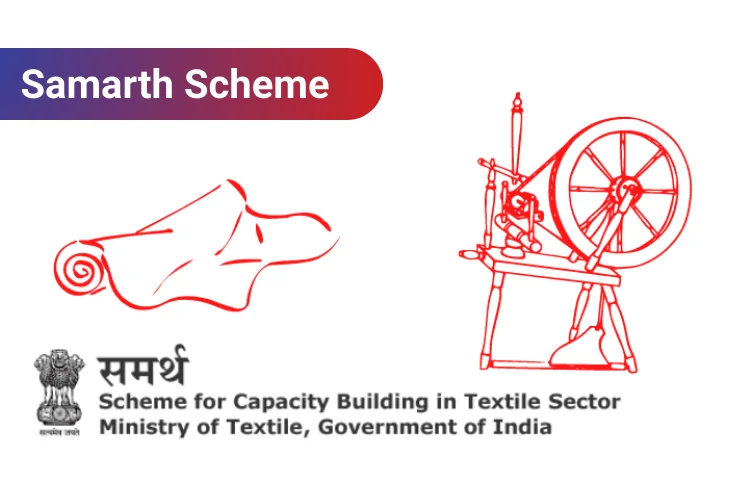The Samarth Scheme, officially known as the Scheme for Capacity Building in Textile Sector (SCBTS), is the flagship skill development initiative of the Ministry of Textiles, Government of India.
When was the Samarth Scheme Launched?
The Samarth scheme was launched in 2017. The scheme aims to address the shortage of skilled labor in India’s textile sector and provide livelihood opportunities through training, placement, and self-employment.
It is a continuation of the Integrated Skill Development Scheme under the 12th Five-Year Plan and is designed to train 10 lakh youth in the organized and traditional textile value chain, excluding spinning and weaving.
Why is the Samarth Scheme in the News?
In January 2025, the Government of India extended the Samarth Scheme till March 2026 with a budget of ₹495 crore. The extension aims to train 3 lakh additional persons in textile-related skills, further boosting employment generation in the sector.
So far, the scheme has trained 3.27 lakh candidates, of which 2.6 lakh (79.5%) have been employed. A significant highlight is that 88.3% (2.89 lakh) of the trained beneficiaries are women, making the scheme a strong driver of women’s empowerment.
What are the Objectives of the Samarth Scheme?
The key objectives of the Samarth Scheme are:
- Provide demand-driven, industry-aligned, and NSQF-compliant training programs.
- Focus on placement-oriented training in organized textile and related sectors.
- Promote skilling, upskilling, and reskilling in traditional sectors like handlooms, handicrafts, sericulture, and jute.
- Ensure sustainable livelihood opportunities through both wage employment and self-employment.
- Empower marginalized groups, such as:
- Women
- SC/ST communities
- Minorities
- Differently abled persons
- BPL (Below Poverty Line) families
- Aspirational districts (identified by NITI Aayog)
Who Implements the Samarth Scheme?
The scheme is implemented by multiple agencies such as:
- Textile Industry (private sector participation).
- Institutions and organizations of the Ministry of Textiles.
- State Governments with training infrastructure and industry tie-ups.
- Reputed training institutions, NGOs, societies, trusts, startups, and companies active in the textile sector with employment linkages.
What are the Key Features of the Samarth Scheme?
The salient features of the Samarth Scheme include:
| Feature | Details |
| Training Target | 10 lakh beneficiaries (initial); 3 lakh more in extension phase (till 2026). |
| Placement Mandate | 70% placement in entry-level training; 90% in upskilling programs. |
| Budget Outlay | ₹1300 crore (2017 launch); ₹495 crore (2025 extension). |
| Technology Integration | – Aadhaar-enabled biometric attendance – CCTV surveillance in training centers – Mobile app-based MIS for monitoring – Call centers & helplines for support |
| Quality Control | – Only certified trainers with ToT certification – Minimum 80% attendance for assessment – Mandatory third-party assessment & certification |
| Special Focus | Women, SC/ST, BPL families, differently abled, minorities, aspirational districts. |
| Grievance Redressal | Multi-level system: call centers, mobile app, official portal. |
How does the Samarth Scheme Benefit the Textile Sector?
The scheme addresses multiple gaps in India’s textile industry:
- Trains workers in modern & traditional sectors.
- Creates industry-ready jobs.
- Focuses on women empowerment.
- Improves textile quality & exports.
- Supports self-employment via credit schemes.
What is the Current Status of the Samarth Scheme?
As of January 2025:
- 3.27 lakh candidates trained.
- 2.6 lakh candidates employed (79.5% placement).
- 2.89 lakh women trained (88.3%).
- Strong presence in traditional crafts and aspirational districts.
- Scheme extended till March 2026 with ₹495 crore allocation.
Get ready to crack government job exams with leading educators
How does the Samarth Scheme Ensure Transparency?
To ensure transparency, accountability, and effective monitoring of training programs, the Samarth Scheme incorporates advanced technological and administrative measures. These mechanisms help maintain the quality of training, track trainee participation, and address any issues promptly, ensuring smooth implementation of the scheme.
- Biometric Attendance
- Video Monitoring
- Online Tracking
- Assessment
- Grievance Mechanism
How Important is the Textile Sector in India?
The textile sector in India is a major source of employment and economic growth. It employs around 45 million people, making it the second-largest sector after agriculture, and provides livelihood to nearly 100 million people in related industries.
The sector contributes approximately 2% of India’s GDP and accounted for 11.4% of the country’s exports in 2020–21. India is also one of the largest producers of cotton, jute, and silk, and has recently become the second-largest producer of PPE kits globally. This highlights the sector’s importance for employment, trade, and overall economic development.
What Other Schemes Support the Textile Sector?
The Samarth Scheme is part of a broader network of government initiatives in the textile industry:
- Amended Technology Upgradation Fund Scheme (ATUFS): Supports modernization through subsidies.
- Scheme for Integrated Textile Parks (SITP): Develops state-of-the-art infrastructure for textile clusters.
- Power-Tex India: For the power loom sector.
- Silk Samagra Scheme: Enhances silk quality and productivity.
- National Technical Textiles Mission (NTTM): Positions India as a global leader in technical textiles.
- Khadi and Village Industries Development Programmes: Support rural and small-scale enterprises.
Are there Other Samarth Schemes in India?
Yes, the name “Samarth” is also used for other unrelated schemes:
- Samarth for PwDs and Families in Crisis: Provides residential care and respite homes for orphans, families in distress, and persons with disabilities (PwDs) from BPL and LIG families.
- Samarth MSME Women Entrepreneurship Drive (2022): Initiative of the Ministry of MSME launched on International Women’s Day to promote women entrepreneurs through skill development and market assistance.
Key Takeaway
| Feature | Details |
| Scheme Name | Samarth (Scheme for Capacity Building in Textile Sector – SCBTS) |
| Ministry | Ministry of Textiles |
| Launch Year | 2017 |
| Extended Till | March 2026 |
| Budget Outlay | ₹1300 crore (initial), ₹495 crore (2025 extension) |
| Target | Train 10 lakh youth (excluding spinning & weaving) |
| Coverage | Organized & traditional sectors (handloom, handicraft, jute, sericulture) |
| Placement Mandate | 70% for entry-level, 90% for upskilling |
| Trained so far | 3.27 lakh (as of Jan 2025) |
| Employed | 2.6 lakh (79.5%) |
| Women Beneficiaries | 2.89 lakh (88.3%) |
| Monitoring | Aadhaar-based biometric attendance, CCTV, MIS |
| Special Focus | Women, SC/ST, minorities, differently abled, aspirational districts |
Questions Based on Samarth Scheme
1. The Samarth Scheme was launched in which year?
- (a) 2015
- (b) 2016
- (c) 2017
- (d) 2018
- (e) 2019
Answer: (c) 2017
2. Which Ministry implements the Samarth Scheme?
- (a) Ministry of MSME
- (b) Ministry of Labour
- (c) Ministry of Skill Development
- (d) Ministry of Textiles
- (e) Ministry of Commerce
Answer: (d) Ministry of Textiles
3. What is the target of the Samarth Scheme?
- (a) Train 5 lakh youth
- (b) Train 10 lakh youth
- (c) Train 15 lakh youth
- (d) Train 20 lakh youth
- (e) Train 25 lakh youth
Answer: (b) Train 10 lakh youth
4. Which two sectors are excluded from Samarth Scheme training?
- (a) Handloom and handicraft
- (b) Sericulture and jute
- (c) Spinning and weaving
- (d) Knitting and processing
- (e) Dyeing and printing
Answer: (c) Spinning and weaving
5. What is the budget outlay approved in 2017 for the Samarth Scheme?
- (a) ₹1000 crore
- (b) ₹1300 crore
- (c) ₹1500 crore
- (d) ₹2000 crore
- (e) ₹2500 crore
Answer: (b) ₹1300 crore
6. The Samarth Scheme extension till 2026 has allocated how much budget?
- (a) ₹250 crore
- (b) ₹350 crore
- (c) ₹495 crore
- (d) ₹600 crore
- (e) ₹750 crore
Answer: (c) ₹495 crore
7. What is the placement mandate for upskilling courses under Samarth?
- (a) 50%
- (b) 60%
- (c) 70%
- (d) 80%
- (e) 90%
Answer: (e) 90%
8. Which of the following is NOT a feature of Samarth Scheme?
- (a) Aadhaar-based biometric attendance
- (b) CCTV in training centers
- (c) Free housing to beneficiaries
- (d) Third-party assessment
- (e) Call center for grievance redressal
Answer: (c) Free housing to beneficiaries
9. What percentage of beneficiaries of Samarth Scheme are women (as of Jan 2025)?
- (a) 70.1%
- (b) 75.5%
- (c) 79.5%
- (d) 83.2%
- (e) 88.3%
Answer: (e) 88.3%
10. Which of the following schemes is related to silk sector development?
- (a) Power-Tex India
- (b) Silk Samagra Scheme
- (c) SITP
- (d) ATUFS
- (e) NTTM
Answer: (b) Silk Samagra Scheme
Also Read:
- MISHTI Scheme, India’s Initiative to Restore Mangrove Ecosystems
- National Green Hydrogen Mission Features, Objectives, and Benefits
- Paramparagat Krishi Vikas Yojana, Transforming India’s Organic Farming
- Mission on Integrated Development of Horticulture NHM and HMNEH
- Swachh Bharat Mission, India’s Journey Towards Cleanliness and Hygiene
- SAGY, A Step Towards Holistic Development of Indian Villages

Hi, I’m Aditi. I work as a Content Writer at Oliveboard, where I have been simplifying exam-related content for the past 4 years. I create clear and easy-to-understand guides for JAIIB, CAIIB, and UGC exams. My work includes breaking down notifications, admit cards, and exam updates, as well as preparing study plans and subject-wise strategies.
My goal is to support working professionals in managing their exam preparation alongside a full-time job and to help them achieve career growth.
